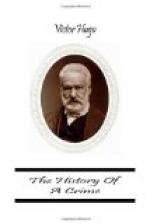From twelve to two o’clock there was in this enormous city given over to the unknown an indescribable and fierce expectation. All was calm and awe-striking. The regiments and the limbered batteries quitted the faubourg and stationed themselves noiselessly around the boulevards. Not a cry in the ranks of the soldiery. An eye-witness said, “The soldiers march with quite a jaunty air.” On the Quai de la Ferronnerie, heaped up with regiments ever since the morning of the 2d of December, there now only remained a post of Municipal Guards. Everything ebbed back to the centre, the people as well as the army; the silence of the army had ultimately spread to the people. They watched each other.
Each soldier had three days’ provisions and six packets of cartridges.
It has since transpired that at this moment 10,000 francs were daily spent in brandy for each brigade.
Towards one o’clock, Magnan went to the Hotel de Ville, had the reserve limbered under his own eyes, and did not leave until all the batteries were ready to march.
Certain suspicious preparations grew more numerous. Towards noon the State workmen and the hospital corps had established a species of huge ambulance at No. 2, Faubourg Montmartre. A great heap of litters was piled up there. “What is all this for?” asked the crowd.
Dr. Deville, who had attended Espinasse when he had been wounded, noticed him on the boulevard, and asked him, “Up to what point are you going?”
Espinasse’s answer is historical.
He replied, “To the end.”
At two o’clock five brigades, those of Cotte, Bourgon, Canrobert, Dulac, and Reybell, five batteries of artillery, 16,400 men,[23] infantry and cavalry, lancers, cuirassiers, grenadiers, gunners, were echelloned without any ostensible reason between the Rue de la Paix and the Faubourg Poissonniere. Pieces of cannon were pointed at the entrance of every street; there were eleven in position on the Boulevard Poissonniere alone. The foot soldiers had their guns to their shoulders, the officers their swords drawn. What did all this mean? It was a curious sight, well worth the trouble of seeing, and on both sides of the pavements, on all the thresholds of the shops, from all the stories of the houses, an astonished, ironical, and confiding crowd looked on.
Little by little, nevertheless, this confidence diminished, and irony gave place to astonishment; astonishment changed to stupor. Those who have passed through that extraordinary minute will not forget it. It was evident that there was something underlying all this. But what? Profound obscurity. Can one imagine Paris in a cellar? People felt as though they were beneath a low ceiling. They seemed to be walled up in the unexpected and the unknown. They seemed to perceive some mysterious will in the background. But after all they were strong; they were the Republic, they were Paris; what was there




